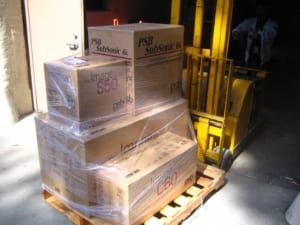 What type of material handling equipment does your business use? It’s no secret that the right equipment will improve both the quality and quantity of work output, while also reducing the risk of worker injury. When workers are forced to lift and manipulate heavy objects themselves, it can place them at risk for a wide variety of musculoskeletal disorders (MSDs), including slipped/herniated disc, muscle sprains, carpal tunnel syndrome, osteoarthritis and more. But the lack of material handling equipment can also impact workers’ productivity, forcing them to exhaust additional time and energy to accomplish the same tasks.
What type of material handling equipment does your business use? It’s no secret that the right equipment will improve both the quality and quantity of work output, while also reducing the risk of worker injury. When workers are forced to lift and manipulate heavy objects themselves, it can place them at risk for a wide variety of musculoskeletal disorders (MSDs), including slipped/herniated disc, muscle sprains, carpal tunnel syndrome, osteoarthritis and more. But the lack of material handling equipment can also impact workers’ productivity, forcing them to exhaust additional time and energy to accomplish the same tasks.
Handtruck
One of the most basic types of material handling equipment is a handtruck. A typical handtruck is capable of holding upwards of 600 pounds, which is far more than the capacity of an average worker. Using a handtruck, workers can safely transport materials from one area to another, without placing unnecessary stress on their bodies. And for the price, handtrucks offer an economical solution to material handling in the workplace.
Forklift
We can’t talk about material handling equipment without mentioning the forklift. According to the Occupational Safety and Health Administration (OSHA), a standard forklift is capable of carrying 4,000 pounds when the load is properly balanced on the forks (source). Keep in mind, however, that a forklift’s total weight capacity begins to drop as the load expands past the forks. OSHA provided an example, saying a load that’s just 8 inches past the forks alters its center of gravity so much that it reduces the forklift’s weight capacity from 4,000 to 2,666 pounds. Nonetheless, forklifts remain an effective type of material handling equipment.
Hoists
They may not see quite the same level of use/application as handtrucks and forklifts, but hoists are still a type of material handling equipment that can be used to boost worker productivity. Hoists allow workers to transport heavy loads across distances by lifting the load and carrying it through the air. The great thing about hoists is that it completely eliminates the need for workers to physically bend down to lift or otherwise manipulate heavy loads. When a worker is constantly forced to bend his or her back to lift objects, it can lead to potentially serious injuries later down the road, as the repetitive, unnatural motion stresses the worker’s back.

